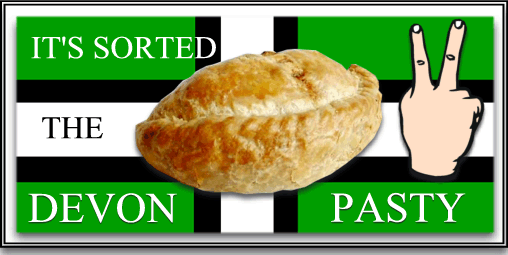
Now, before we start, I should just like to say to any governmental representative of Blair’s bunch that this is not an attempt to incite racial hatred. If in any way it’s deemed as such I would like to humbly apologise now as that was not the intention.
BUT… the ‘Pasty War’ has finally been won. In Exeter they are ecstatic, in Plymouth they’re ‘pleased as punch’, in Barnstaple they’re beaming and in Cornwall they’re looking very pastey and crying. Why? because after centuries of racial tension the big debate had finally been answered – the Devonians first invented the PASTY! This fantastic news has been heralded to the county by The Western Morning News and has made front-page headlines. As we speak a team of top Devon lawyers are ‘allegedly’ preparing a case of mis-representation to be presented to the Office of Fair Trading in which Cornwall will be charged with ‘allegedly’ falsely calling the humble pasty ‘Cornish’. So what startling revelation has finally settled the argument that has tumbled down through the centuries – simple a piece of paper. Not any old piece of paper mind, but an old document dating back to 1510. Dr. Todd Gray found the entry in the ‘Audit Book and Receiver’s Accounts for the Borough of Plymouth’. In this venerable document there are four lines which pertain to the cost of making a pasty with venison. If your palaeography is up to scratch you can see the word ‘pasty’ in the vital extract from the document below:
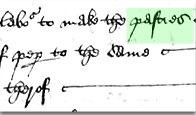
Ironically the deer meat for this pasty came from the Mount Edgecombe estate in Cornwall – probably because the Devonshire venison was of too high a quality to put in pasties. Dr. Gray has also checked with the Cornish Records Office who confirmed that the earliest entry they have for a pasty was from 1746 which is 236 years later. In which case this could suggest that the recipe was allegedly stolen from Devon, possibly by some pirates on their way back home to the Mousehole.
Despite this irrefutable evidence there are mutterings wafting across the Tamar that although the pasty may have sprung from the very bedrock of Devon, the Cornish improved the recipe and made it what it is today, ‘Teddy in the corner’ or what?
Another astonishing claim emanating from Kernow and the author of ‘The Official Encyclopaedia of the Cornish Pasty’ is that they were around in Cornwall as far back as 8,000 – 10,000BC? Which according to my reckoning coincides with what is loosely termed the ‘Late Upper Palaeolithic’ and ‘Mesolithic’ periods. This is the age of the hunter-gatherer so does that mean that early Kernewek man was hunting pasties or gathering them, presumably off a pasty bush? But don’t mock, this could be possible though, there is evidence that during the Lower Palaeolithic period there was a fast-food pasty drive-in at Kent’s Cavern, just next door to the Wetherspoon’s pub. But no, don’t laugh, seriously now, in fact numerous archaeological excavations at early Cornish Mesolithic sites have turned up fossilised pasties in context and below is a photo of one. In fact if you look closely at the example you can see an entry wound of a spear in the bottom left-hand corner. Experts have suggested that this wound would have come from a hunter’s spear and have been the likely cause of the pasty’s death.
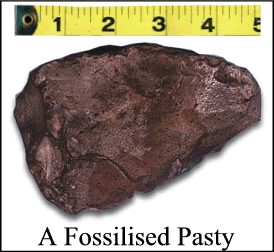
So fair do’s, seeing is believing, and being no expert on the Cornish language, I presume the word ‘pasty’ or ‘pasti‘ in local parlance translates to the English term – ‘Mesolithic Hand Axe’.
A spokesperson for the Cornish Pasty Association (they’re going to have to change their name) is reported as saying:
“In medieval times they always used pastry as a vessel for serving – they would eat the insides and throw the pastry away. I think it was going on as early as the 1100’s…“.
In which case why go to the bother of making pastry, baking a pasty, eating the filling and then throwing it away? – sounds a bit ‘Bodmin’ to me! Anyway, an official seminar was held in Plymouth on the 11th of November to reveal the good news to Devon.
If anyone would like the recipe for a ‘proper job’ pasty as baked in the traditional way of its Devonshire birthplace then ‘yer tis’:
The ORIGINAL Devonshire Pasty – as first eaten in Plymouth circa 1520!!!
Ingredients:
1lb Shortcrust Pastry
1lb lean, chopped beef – raw or 1lb of scraggy Cornish venison – raw.
2 medium sized, finely chopped potatoes – raw
1 medium chopped onion – raw
1 medium chopped swede – raw
1 beaten egg
salt and pepper
Method:
Roll out pastry to ¼” thick and cut out 4 dessert plate sized circles.
On to each place layers of the above ingredients and season well, especially with the pepper.
Moisten the edges and fold over into a ‘Mesolithic hand-axe’ shape and then press the edges firmly together and crimp along the join. Forget the Cornish nonsense about ‘cock’ and ‘hen’ crimping, that goes back to the days when pasties were poached from Devon and one of each made a brace.
Make a small ‘entry wound’ type slit in the top to let the steam escape, please note this is not to let the pasty’s spirit leave the body as some west of the Tamar would have you believe.
Repeat the above process with all four pasties and then place on a baking sheet and put in a pre-heated oven (400ºF) until the pastry turns to a pale golden colour.
Take the pasties out of the oven and brush with the beaten egg and shove back in the oven.
Reduce the temperature to 350º and bake for a further 40 minutes.
The pasties are always best eaten hot but do make for ideal cold meals, please note; there is no need to throw away the pastry after you have eaten the filling. If you do want to do this try making a stew instead, it saves time messing around with the pastry!
This page has meant to be a light-hearted comment on the pasty debate and I hope it has caused no offence to our Cornish neighbours. If it has, then in the words of their very own ‘bard’ – Jethro – ******k’s anyway – the pasty originates from DEVONSHIRE – along with clotted cream!
Addenda
Oh, the story is not over, The Independent newspaper (13th November 2006, pp.10 – 11)carried a full 2 page feature which went into depth regarding the new findings and elucidates a bit further on the story. According the them, the author of ‘The Official Encyclopaedia of the Cornish Pasty’ also stated that, “ancient Cornish cave paintings confirm the existence of pasties in prehistoric times.” Well, what a thing to say, but let’s not get too pasty – sorry hasty, maybe there is a grain of truth in this because if the Cornish have found fossilised pasties why should the ancient pasty hunters not depict such things?
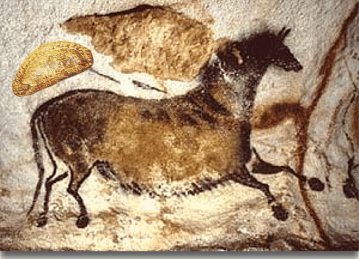
Painting from the famous Launcells cave system.
You can see from the above picture which is depicted on the Lascaux, sorry Launcells, cave that not only has the horse got an arrow sticking in it so has the pasty. Could this scene depict a hunting scene from 15,000 years ago or is it a fake which is meant us to give credence to the prehistoric pasty theory?
Even worse than that, the Independent article also stated that there is even earlier documentary evidence than the Plymouth record of 1510. According to the writer there is mention of a pasty in the 12th century work of a Frenchman called Chretien de Troyes. He wrote several Arthurian romances and in one of them, ‘Eric and Enid’ the following lines appear, “Next Guivert opened a chest and took out two pasties. ‘My friend,’ says he, ‘now try a little of these cold pasties.” In this light, the reporter, Terry Kirkby suggests that Guivert and Eric were supposed to have haled from Cornwall ergo the pasty is Cornish. Well, what a liberty, how can a tract from a ‘Romance‘ written by no less than a Frenchman called Cretin or some such pronunciation about two of King Arthur’s knights called ‘Eric‘ and ‘Guivert’ be deemed as credible? Huh, an Arthurian knight called Sir Eric sounds really romantic that – I suppose he slayed the ‘Big Bad Wolf’, married Snow White and they all lived happily ever after in ‘La La Land’ with there seven ‘bouncing’ dwarfs. The next thing you know the folks from Somerset will be saying the pasty originated there because in some long lost page of the Anglo Saxon Chronicles it states that the cakes King Alfred burnt were in reality pasties – in fact that is much more plausible.
Another point that Terry Kirkby makes is that close cousins to the pasty are the samosas and empanadas of India and Spain and that these stem from the oldest cuisine in the world that was introduced by the, “Moghuls and Moors,” – exactly, introduced by the Moors as in Dartmoor – as in Devonshire! I knew this whole story would end up on Legendary Dartmoor somehow !
Finally, Terry Kirkby ( I bet he’s Cornish) notes that the ‘Pasty Pound’ or revenue from the pasty industry is worth £60 million pounds to Cornwall – no wonder they are getting so grizzly about it! Cave paintings, knights called ‘Eric’, Frenchmen, Cretins, Samosas, Empanadas, and Moguls – desperate or what? Mind you for 60 million ‘Pasty Pounds’ you can’t blame them.
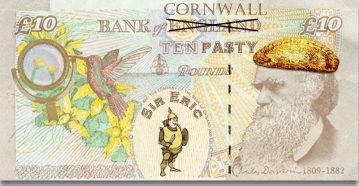
 Legendary Dartmoor The many aspects past and present of Dartmoor
Legendary Dartmoor The many aspects past and present of Dartmoor

Too funny for any more words.. the Devonshire pasty is the real one!